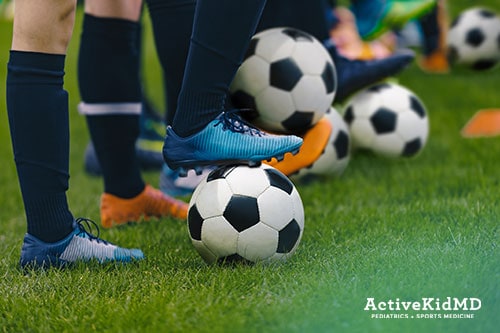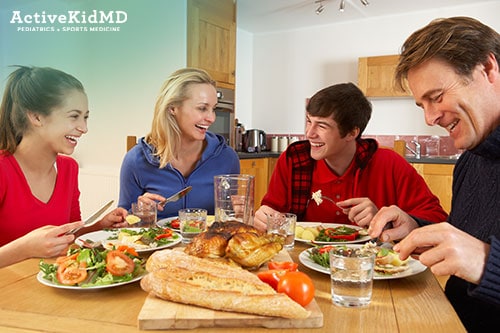Have you noticed that your teenage athlete had a big growth spurt over the last few months?
I’ve seen several young athletes recently for annual physicals and found that many of them have grown quite a bit taller since March.
This shouldn’t be a major surprise.
In the past, athletes and other performers/dancers who have taken months off have also tended to experience growth spurts.
So, why have athletes grown taller when not spending time on the field or court?
Without the higher energy demands from full sports activities (even the best on-line workouts don’t equal the fitness expenditures of full-speed sport activities), the body can dedicate more calories to overall height accumulation.
- Athletes spending more evening hours at home get increased numbers of home-cooked meals which tend to deliver better nutrient and caloric amounts needed for growth.
- Then “at the end of the day” you throw in probably the most important variable for promoting more growth – sufficient sleep!
Without having to balance school, homework, and practice/rehearsal/private lessons/competition commitments, suddenly the goal of 8 hours of sleep is being attained on a nightly basis.
Now, those growth spurts do bring some challenges with them.
How should coaches, instructors, and parents be prepared for when those taller athletes return to play?
- Expect more awkward movements. The previously graceful gymnast who floated across the floor now routinely trips over everything. The key muscle support groups behind the shoulders and hips often need more developmental time to adequately control movements of the now longer arms and legs. In addition, the central nervous system also needs time to catch up with coordinating movements, overall balance, and joint positioning.
- Anticipate earlier fatigue due to that lack of central strength. Plan on fewer numbers of skill repetitions, sprints, and leaps/jumps with longer rest periods between sets of each.
- Overall soft tissue flexibility will be reduced, as increases in length of muscles, tendons and ligaments often lag behind bone growth.
- Expect more soreness, especially at points called apophyses where larger muscles attach to growth areas of bone. Prime examples include the hamstrings coming off the pelvis, quadriceps attaching to the shin bone, and the calf muscles ending at the heel bone.
- There will be a higher center of gravity which may affect turns, leaps, and changing direction.
- Equipment may not fit- there could likely be a need for larger shoes, protective pads, helmets, and sport-specific items such as bats, gloves, and sticks.
- Instructors might have to identify different weight-lifting patterns due to changes in height and strength.

Individualized assessment of technique and core strength development (again, back of shoulders, hips, and abdominal region should be a priority. Don’t be afraid to move slow and focus on quality and details rather than quantity and rapid advancement.
Certain sports involve high volume jumping, landing and changing of direction – especially on one leg – such as soccer, basketball, and volleyball. Young female players who have just completed a growth spurt have entered a higher-risk time for Anterior Cruciate Ligament (ACL) tears due to mechanical changes from longer legs, higher center of gravity and less hip strength. I cannot emphasize enough how this is an ideal time to focus on evidence-based ACL injury reduction programs that address those growth issues by teaching safer movement patterns.
How about flexibility and stretching?
This is probably not as high of an initial emphasis.
While many athletes may be concerned about lack of flexibility, trying to over stretch during or right after a growth spurt can actually do more harm than good. Overstretching can tear muscle fibers leading to longer-term pain and reduced strength. It can also lead to avulsion fractures at those apophyseal growth areas which are often the “weakest link” during rapid growth. A fractured apophyses can take months to properly heal.
It is better to focus on development of central/core strength which then naturally leads to less tension and more flexibility in the longer muscles. For example, more proper activation and control of the hip gluteal muscles reduces stress on both the hamstring and iliotibial band regions of the legs.
Once more “usual schedules” resume, we should continue to remember the importance of adequate caloric intake and sleep in the long-term growth and development of our teenage athletes and performers.
Hopefully there will be more time carved out for those home meals, even if it means a reduction in total practice time or private sessions. Not only does a good dinner help build stronger athletes, but it also can build stronger social connections for families.
The extra sleep (again at least 8 hours a night for high school students) is also absolutely essential for both physical and cognitive performances.
We won’t expect that athletes who continue to get more energy intake and sleep to keep getting taller. Obviously, there is an end point to final maximum height (can thank mom and dad for that).
Just imagine those extra calories and hours of sleep being converted into developing and maintaining muscles (increased volume and number of motor units) and bones (higher bone mineral density).
That means stronger and more resilient young athletes who will better handle repetitive forces and have reduced risk of overload stress injuries.
Dr. Chris Koutures is a dual board-certified pediatric and sports medicine specialist who practices at ActiveKidMD in Anaheim Hills, CA. He is a team physician for USA Volleyball (including participating in the 2008 Beijing Olympics), the U.S. Figure Skating Sports Medicine Network, Cal State Fullerton Intercollegiate Athletics, Chapman University Dance Department, and Orange Lutheran High School. He offers a comprehensive blend of general pediatric and sport medicine care with an individualized approach to each patient and family. Please visit activekidmd.com or follow him on Facebook (https://www.facebook.com/activekidmd/), Instagram (https://www.instagram.com/activekidmd/), or Twitter (@dockoutures).


 Without the higher energy demands from full sports activities (even the best on-line workouts don’t equal the fitness expenditures of full-speed sport activities), the body can dedicate more calories to overall height accumulation.
Without the higher energy demands from full sports activities (even the best on-line workouts don’t equal the fitness expenditures of full-speed sport activities), the body can dedicate more calories to overall height accumulation.